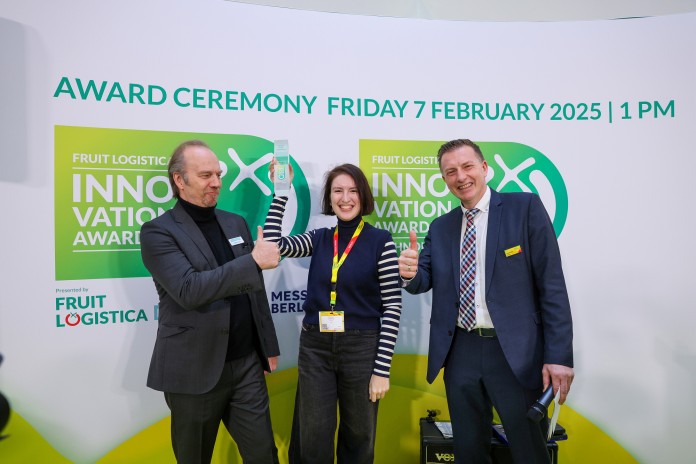AMFRESH’s Onix Orange was named most innovated product of the year at the 2025 Fruit Logistica show in Berlin, while Croptimus from Fermata took home top Technology honours for its ability to quickly detect diseases and pests in greenhouses.
The two winners were chosen by public vote from visitors who cast their ballots during the three-day trade show at Messe Berlin.
The Onix orange was a big hit with guests, with its brilliant fright flaming orange to deep burgundy red colour as well as its juicy, naturally pigmented flesh. Boasting high antioxidant and vitamin content, as well as great shelf life, AMFRESH Spain Citrus calls the fruit a “sustainable citrus wonder” for premium consumers.
“We have this amazing, out-of-this-world fruit that is grown in the sunny orchards of Spain, and being able to deliver that to the world is such a gift,” Patricia Sagarminaga, Global Director Marketing and Communications at Amfresh Group, said. “To win this award is a tremendous recognition for the breeder, the grower, and for everyone at Amfresh and Genesis Fresh.”
Meanwhile, Israel-based Fermata wowed with its Croptimus image analysis technology, earning more than half of the votes from attendees. As software as a service (SaaS), it requires no additional hardware and can work with both installed cameras and smartphone images. Fermata promises up to 50% less scouting effort, 30% less crop loss and 25% less input consumption.

“I feel amazing. It’s my first time at FRUIT LOGISTICA, and I’m very impressed by the scale and quality of the event. We are absolutely privileged to be part of it and to be recognized by it as well,“ said Valeria Kogan, Founder and CEO of Fermata.
Awards, AI highlight event
This year’s Fruit Logistica events, forums, and even chats focused on new potential technology and how to utilize it and Artificial Intelligence in different steps of the way in the produce sector.
On the first day of the event, the founder of Aglife Media, Inc. and host of The Produce Industry Podcast, Patrick Kelly, and head of international fruit trade at the American Crown Global Corporation/UGBP USA, Federico Tavares, spoke about how digital technologies and tools play a crucial role along the supply chain.
During his session at the Fresh Produce Forum, Kelly said that “digital innovations redefine the supply chain,” and spoke on how the digital world is changing communication, marketing, and advertising, urging the fresh produce industry to think broadly and utilize all the mediums at our hands to reach different markets.
He said the expansion of technology makes everyone “more than just a point in the huge global mass along the supply chain. “You determine how you tell the story of your brand. Show where you come from, who you are, and what your vision for the future is.” He said brands shouldn’t completely write off traditional print media but definitely it should be used for unique campaigns and designs, in combination with social media and videos.
On the other hand, Tavares brought along examples from everyday life along the supply chain, and asked producers in Brazil “how they would particularly like to be supported by digitalization.” Many said they would like to find a solution for the tedious manual inputting of data, the lack of transparency and inefficient communication between suppliers and customers.
He said to address the data issue, the Using the Observatory of Economic Complexity (OEC) data platform for international trade data has helped him with targeted planning, identifying sales markets and transport issues, and said this digital program could be of use to many suppliers and producers too.
Tavares also cited other digital tools, Tavares cited how papaya farmers in Brazil use “a management and control system to track every fruit from harvest to final delivery. Controlling and warehouse management are also carried out using this system.”
Artificial Intelligence to sustainable control insect pests
This same day, Scientist and Scientist and entomologist, Dr Silvia Schmidt, spoke on how sensor traps and AI can make the use of insecticides more efficient and sustainable.
During the session, Schmidt presented biological methods for controlling harmful organisms in the Future Lab at Fruit Logistica. As head of the “Biological Plant Protection Methods” working group, she is coordinating a project to develop intelligent traps.
Various prototypes of pest monitoring data and traps have been developed in recent years.
Slovenian company EFOS presented its Trapview platform during the event, a trap data based on artificial intelligence that helps customers obtain an accurate and timely understanding of pest population dynamics and a forecast of pest development stages in a given area, is used to monitor more than 60 different insect species worldwide.
The tools could lead to a reduction in synthetic insecticides, more efficiency through perfect timing use, and advanced processing of case data.
Currently, the identification and capture of insects are carried out by human staff through costly and time consuming field visits, but, according to the doctor, “with the help of high-resolution images in the traps, real-time monitoring and identification and counting of the species, a lot of labor can be saved.”
“Knowing the perfect timing for treatment could minimize crop losses, reduce chemical residues in products, cut production costs, CO2 emissions and overall costs through pest control and prevention measures,” she explained.”AI in agriculture is not just about increasing yields. It’s about making agriculture more sustainable and efficient for future generations,” says Silvia Schmidt.
Bees and drones
Beehero, a precision pollination provider, manages more than 300,000 beehives worldwide and collects 25 million pieces of data every day. According to the brand’s Vice President, Eytan Schwartz, their “IoT sensors on the honeycombs translate the buzzing of the bees into information, like Google Translate, and we can then see what is going on in the hives.”
The VP said that the Pollination Insight Platform (PIP) data platform also makes it possible to monitor bee activity directly in the field and see where and what the bees are really pollinating.






